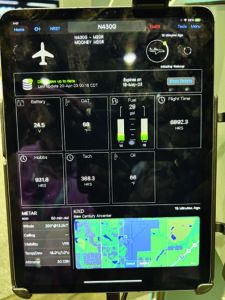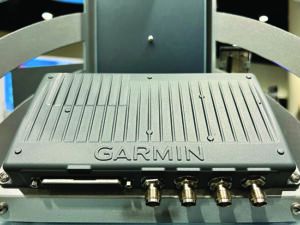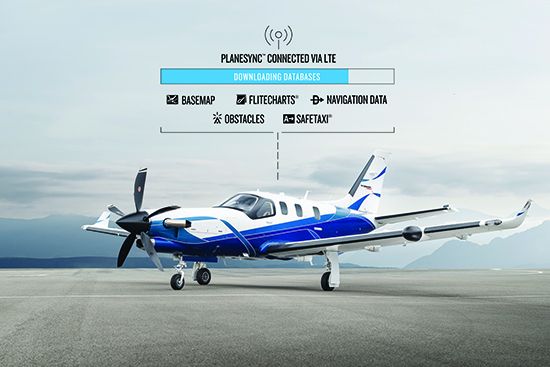There probably aren’t many pilots who fly behind a suite of modern avionics who haven’t gone to the airplane to launch on a trip only to realize they forgot to bring the data cards for loading in the latest nav data. That’s one inconvenience Garmin attempts to solve with its new PlaneSync system.
PlaneSync takes panel connectivity to a new level, with the ability to ping the avionics from a distance using the Garmin Pilot app or the latest Garmin aviator watch. PlaneSync uses the new GDL 60 datalink transceiver that connects the user with the airplane (and the airplane with a virtual cloud) from anywhere there’s a Wi-Fi or cellular connection.
THE INTERFACE
The graphic below illustrates PlaneSync’s navigation data transfer potential, and the Daher TBM turboprop with Garmin G3000 avionics is just one OEM PlaneSync interface that’s been in service. Piper’s M600 turboprop will have it, too. At press time, Garmin announced the PlaneSync interface for the aftermarket. When it’s available later this year, it will work with a variety of Garmin retrofit avionics including the G500/600 TXi flight displays, GI 275/EIS electronic flight instruments and GTN Xi series navigators.
The brain of the PlaneSync interface lives in the remote-mounted GDL 60 datalink transceiver. This has built-in 4G LTE, Wi-Fi and Bluetooth connectivity, and in addition to making a cellular or Wi-Fi connection with the app and Garmin’s Aviation Cloud, it also streams a variety of data sources in the cockpit—weather, traffic, flight plan and attitude information—just as Garmin’s Flight Stream units have been doing.
When the aircraft is within LTE or Wi-Fi coverage, the GDL 60 maintains current avionics databases including nav data, SafeTaxi, en route/terminal charts, terrain and obstacles. If the aircraft is outside LTE and Wi-Fi coverage, databases can be updated wirelessly through Garmin’s Database Concierge (using Garmin Pilot), just like a Flight Stream interface. The GDL 60 is able to offload maintenance and flight data to Garmin’s Aviation Cloud infrastructure.
FOCUS ON SAVING POWER

Since the system requires a hot battery bus for data transfers to and from the aircraft, power management was front and center during Garmin’s development of the GDL 60, and the system has a sizable degree of configurability for an allocated battery budget. Maybe you only want it to use 20 percent of the battery’s power, for example. You can also install a dedicated battery for PlaneSync. Additionally, the aircraft battery could be connected to a battery tender, and the system is smart enough to recognize it. But tendering won’t always work while parked away from home.
The GDL 60 has multiple power modes and wakeup triggers. There’s normal operating modes where the unit is fully powered on when the aircraft alternator is on and the avionics bus is energized. In battery-powered wakeup mode, the main gateway portion of the GDL 60 remains powered off while the cellular and Wi-Fi (and eMMC) router portion is powered on to allow data transfers to/from the aircraft while the rest of the aircraft is powered off. The GDL 60 requires a wakeup trigger to transition from one of its sleep modes into battery-powered wakeup mode. In standby/sleep mode, the LTE is always on for on-demand remote wakeup. In deep sleep or minimal power mode, all of the GDL 60 circuits are off except for the RTC (real-time clock), which enables the GDL 60 to come alive when new databases are available and on a configurable wakeup interval. Basically, it wakes up (controlling relays) and takes measurements from connected systems and then goes back to sleep. Power draw in this mode is no more than a clock with keep-alive voltage.

As one example, in a G500 TXi with EIS engine data interface, the GDL 60 wakes up the display and the engine data concentrator and fetches and stores the data. Since a display needs to power up, the GDL 60 is smart enough to back the display brightness down to an absolute minimum (low power mode) to save on current draw. Moreover, the GDL 60 is designed to turn off when aircraft power is removed in flight to support load shedding. In normal operation, the amount of time the equipment is powered up depends on the task and the quality of the data connection; monthly database updates take the longest. The preferred connection is Wi-Fi for faster data transfer. In a typical scenario, the GDL 60 might use a Wi-Fi connection at the aircraft’s home base and use the LTE cellular network when the aircraft is traveling and Wi-Fi is not available.
ANTENNAS, COMPATIBILITY
The GDL 60 requires a client antenna and Garmin offers the GA 61 LTE/Wi-Fi combination external blade antenna (for best reception), or an internally mounted antenna that might secure under the glareshield or under the headliner. The GDL 60 Wi-Fi/Bluetooth Access Point (AP) antenna provides signal between the GDL 60 and devices in the cabin.
In its most basic interface, a GDL 60 with a GTN Xi GPS only automates database updates. For a remote aircraft systems (and position) query to check fuel levels, Hobbs and tach time, battery voltage and OAT, you’ll need a Garmin G500/600 TXi display or GI 275 with Garmin EIS engine interface. At press time the Garmin G3X Touch and G1000 interfaces weren’t yet announced, but we suspect they are in the works.
A future interface includes the ability for PlaneSync to automatically transmit flight and engine log data to the flyGarmin.com web portal.
PRICING
The GDL 60 datalink unit is $3995, and you’ll also need a PlaneSync subscription. The LTE North America plan is $30 per month ($45 for worldwide) for automatic database updates via LTE, Wi-Fi, auto flight log upload and remote aircraft status. A Wi-Fi only subscription (no database updates via LTE) and no remote aircraft status capability is $10 per month.
Visit www.garmin.com.





